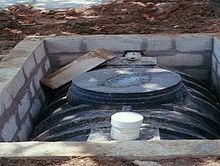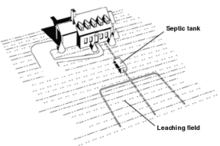| Revision as of 13:09, 24 August 2007 editSewer Me (talk | contribs)38 editsmNo edit summary← Previous edit | Revision as of 14:08, 24 August 2007 edit undoSewer Me (talk | contribs)38 edits →Potential problemsNext edit → | ||
| Line 49: | Line 49: | ||
| #Excessive water entering the system will overload it and cause it to fail. Checking for plumbing leaks and practicing water conservation will help the system's operation. | #Excessive water entering the system will overload it and cause it to fail. Checking for plumbing leaks and practicing water conservation will help the system's operation. | ||
| #If the system is damaged or malfunctions, contact your local health or environmental authority before attempting any repairs. Improper repair can result in costly mistakes and potential health hazards. | #If the system is damaged or malfunctions, contact your local health or environmental authority before attempting any repairs. Improper repair can result in costly mistakes and potential health hazards. | ||
| #Septic tanks by themselves are ineffective at removing Nitrogen compounds that can cause ] in receiving waters, this can be remedied by using a Nitrogen reducing technology | |||
| ==Environmental issues== | ==Environmental issues== | ||
Revision as of 14:08, 24 August 2007
 |
 |
 |
A septic tank, the key component of a septic system, is a small scale sewage treatment system common in areas with no connection to main sewerage pipes provided by private corporations or local governments. (Other components, typically mandated and/or restricted by local governments, optionally include pumps, alarms, sand filters, and clarified liquid effluent disposal means such as drain fields, ponds, or peat moss beds.) Septic systems are a type of On-Site Sewage Facility (OSSF). In North America approximately 25% of the population relies on septic tanks; this can include suburbs and small towns as well as rural areas. In Europe they are generally limited to rural areas only.
The term "septic" refers to the anaerobic bacterial environment that develops in the tank and which decomposes or mineralizes the waste discharged into the tank. Adding a supplemental bacterial agent to the tank will accelerate the digestion of solids in the tank. Septic tanks can be coupled with other on-site wastewater treatment units such as Biofilters or aerobic systems involving artificial forced aeration.
Periodic preventive maintenance is required to remove the irreducible solids which settle and gradually fill the tank, reducing its efficiency. In most jurisdictions this maintenance is required by law, yet often not enforced. Those who ignore the requirement will eventually be faced with extremely costly repairs when solids escape the tank and destroy the clarified liquid effluent disposal means. A properly cared for system can last for decades and possibly a lifetime.
The hose used to remove the waste solids from the septic tank to the truck's tank is called the "honey dipper". The trucks which carry the removed materials away are euphemistically called "Honey Trucks".
Description
A septic tank generally consists of a tank of between 1,000 and 1,500 gallons (4000 - 5500 litres) which is connected to an inlet wastewater pipe at one end and to a septic drain field at the other. These pipe connections are generally made via a T pipe which allows liquid entry and egress without disturbing any crust on the surface. Today the design of the tank usually incorporates two chambers (each of which is equipped with a manhole cover) which are separated by means of a dividing wall which has openings located about midway between the floor and roof of the tank.
Wastewater enters the first chamber of the tank, allowing solids to settle and scum to float. The settled solids are anaerobically digested reducing the volume of solids. The liquid component flows through the dividing wall into the second chamber where further settlement takes place with the excess liquid then draining in a relatively clear condition from the outlet into the leach field, also referred to as a drain field, or seepage field, depending upon locality.

The remaining impurities decompose in the soil, and the water is eliminated through percolation into the soil, and eventually taken up through the root system of plants or added to the groundwater. A piping network, often constructed in a stone filled trench (see weeping tile), distributes the wastewater throughout the field with multiple drainage holes in the network. The size of the leach field is proportional to the volume of wastewater and inversely proportional to the porosity of the drainage field. The entire septic system can operate by gravity alone, or where topographic considerations require, with inclusion of a lift pump.
An Imhoff tank is a two stage septic system where the sludge is digested in a separate tank. This avoids mixing digested sludge with incoming sewage. Also some septic tank designs have a second stage where the effluent from the anaerobic first stage is aerated, before it drains into the seepage field.
Waste that is not decomposed by the anaerobic digestion eventually has to be removed from the septic tank or else the septic tank fills up and undecomposed wastewater discharges directly to the drainage field. Not only is this bad for the environment, but if the sludge overflows the septic tank into the leach field, it may clog the leach field piping requiring expensive repairs.
How often the septic tank has to be emptied depends on the volume of the tank relative to the input of solids, the amount of indigestible solids and the ambient temperature (as anaerobic digestion occurs more efficiently at higher temperatures). In general it is rare for a septic tank system to require emptying more than once a year, and by careful management many users can reduce emptying to every 3 to 5 years. When emptying a tank, only a small residue of sludge should be left in the tank. Anaerobic decomposition is rapidly re-started when the tank re-fills.
A properly designed and normally operating septic system is odor free and besides periodic inspection and pumping of the septic tank should last for decades with no maintenance.
A well designed and maintained concrete, fiberglass or plastic tank should last about 50 years.
Potential problems
- Excessive dumping of cooking oils and grease can fill up the upper portion of the septic tank and can cause the inlet drains to block. Oils and grease are often difficult to degrade and can cause odor problems and difficulties with the periodic emptying.
- Flushing non-biodegradable hygiene products such as sanitary towels and cotton buds will rapidly fill or clog a septic tank and these materials should not be disposed of in this way.
- The use of waste macerators or grinders for disposal of waste food can cause a rapid overload of the system and early failure.
- Certain chemicals may damage the working of a septic tank, especially pesticides, herbicides, materials with high concentrations of bleach or caustic soda (lye) or any other inorganic materials such as paints, solvents etc.
- Roots from trees and shrubbery growing above the tank or the drain field may clog and or rupture them.
- Playgrounds and storage buildings may cause damage to a tank and the drainage field. In addition, covering the drainage field with an impervious surface, such as a driveway or parking area, will seriously affect its efficiency and possibly damage the tank and absorption system.
- Excessive water entering the system will overload it and cause it to fail. Checking for plumbing leaks and practicing water conservation will help the system's operation.
- If the system is damaged or malfunctions, contact your local health or environmental authority before attempting any repairs. Improper repair can result in costly mistakes and potential health hazards.
- Septic tanks by themselves are ineffective at removing Nitrogen compounds that can cause algae blooms in receiving waters, this can be remedied by using a Nitrogen reducing technology
Environmental issues
Some pollutants, especially sulfates, under the anaerobic conditions of septic tanks, are reduced to hydrogen sulfide, a pungent and toxic gas. Likewise, nitrates and organic nitrogen compounds are reduced to ammonia. Because of the anaerobic conditions, fermentation processes take place, which ultimately generate carbon dioxide and methane, both of which are known greenhouse gases.
The fermentation processes cause the contents of a septic tank to be anoxic with a low redox potential, which keeps phosphate in a soluble and thus mobilized form. Because phosphate can be the limiting nutrient for plant growth in many ecosystems, the discharge from a septic tank into the environment can trigger prolific plant growth including algal blooms which can also include blooms of potentially toxic cyanobacteria.
Soil capacity to retain phosphorus is large compared with the load through a normal residential septic tank. An exception occurs when septic drain fields are located in sandy or coarser soils on property adjoining a water body. Because of limited particle surface area, these soils can become saturated with phosphate. Phosphate will progress beyond the treatment area, posing a threat of eutrophication to surface waters.
In areas with high population density, groundwater pollution levels often exceed acceptable limits. Some small towns are facing the costs of building a very expensive centralized wastewater treatment system because of this problem, owing to the high cost of extended collection systems. Too often, the efficient and economical alternative of a properly designed decentralized wastewater treatment plant is not considered.
To slow pollution, building moratoriums and limits on the splitting of property are often imposed. Ensuring existing septic tanks are functioning properly is also helpful for a limited time, but it is not the solution. Once polluted, groundwater is very slow to clean - thus urgent action is appropriate.
The common expression the grass is always greener over the septic tank (which is also the title of an Erma Bombeck book) is technically incorrect. The grass is greener over the leach field, which is better watered and has more nutrients than the surrounding land. However, it is not unusual to find better growth over the septic tank itself as well, particularly the end nearer the leach field.
"Septic tank" in slang
In Cockney Rhyming Slang (common in Britain and Australia) "septic tank" or, more commonly, simply "septic" or "seppo" is used as a pejorative word for an American, based on a rhyme for "Yank". The pejorative nature of the term is further underlined by its referral to a container for storing human waste. See also "Sherman Tank" (= wank).
In an episode of the British panel show "Q.I.", Stephen Fry mentioned the neologism "listerine", from a mouthwash whose antiseptic properties made it suitable for rhyming slang use to refer to anti-Americans.
The term Honey wagon is a euphemism originally referring to a horse drawn wagon carrying a tank of liquid manure or sewage. Today a tanker truck equipped with a sludge pump to empty septic and conservancy tanks is also euphemistically known as a "honey sucker".
See also
- Backwater
- Bioreactor
- Cesspit
- Ecological sanitation
- Grease Trap
- Latrine
- Outhouse
- peat moss
- Perc test (Percolation testing for the capacity of soil to absorb water)
- Pit toilet
- Plumber
- Plumbing
- Sepsis
- Septage
- Sewage treatment
- Sewer
- Stink Pipe
- Waste disposal
External links
- EPA on septic tanks
- Do's, Don'ts, & Problem-solving, at a range of costs
- Septic tank vent stack odor control
- Restore clogged septic and drainfield and eliminate pump-outs
- How to design and build a ferrocement septic tank
- USEPA's National Small Flows Clearinghouse, Morgantown, West Virginia, USA (http://www.epa.gov/owm/mab/smcomm/nsfc.htm)
References
- "Septic Systems for Waste Water Disposal". American Ground Water Trust. Retrieved 2006-07-11.
- "Septic Tanks: The Real Poop". University of California Extension. Retrieved 2006-07-11.
- Craig G. Cogger. "eb1475 Septic System Waste Treatment in Soil". College of Agriculture and Home Economics, Pullman, Washington. Retrieved 2006-07-11.